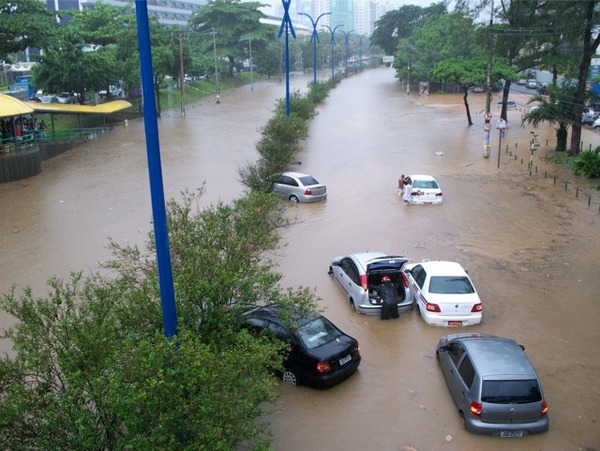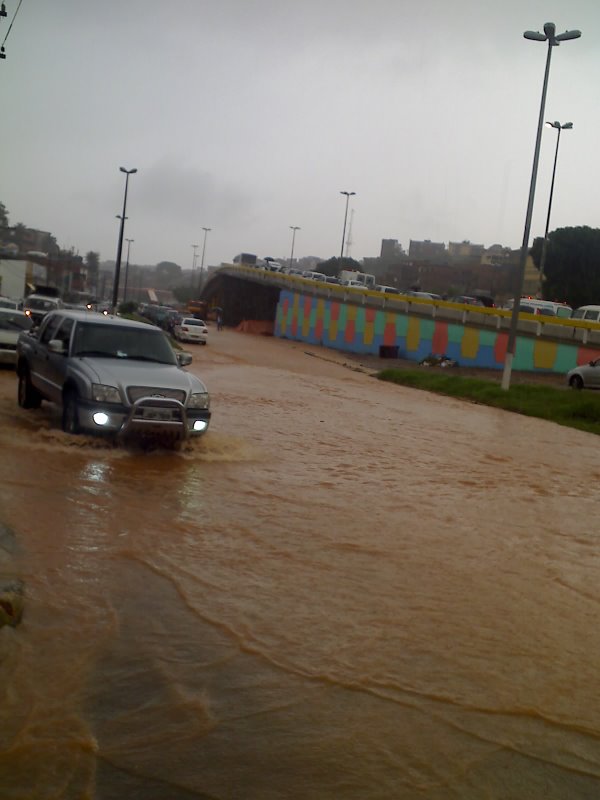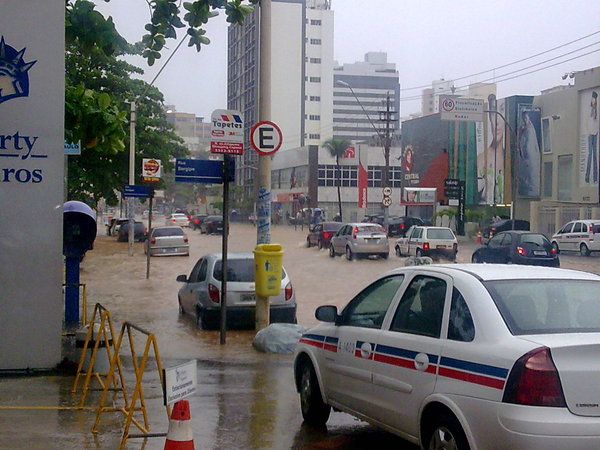On the Tuesday May 5th, Salvador, the original capital of Brazil, experienced moments of desperation with the strong rain that overran the whole city. Hundreds of incidents were reported to the Civil Defense, which had recorded 392 requests for emergency care by 7pm of the same day. In addition to collapsed houses, fallen trees and landslides, there were also massive traffic jams which brought chaos to drivers and commuters.
Deaths were reported in areas where houses are condemned due to lack of infrastructure and the imminent risk of collapse, three of them in the neighborhood of Pirajá. Also, a mother and a daughter fell into a canal and were dragged away by the strong current. The mother's body was found on Wednesday morning, the daughter's only one day after, on May 7th.
The event, which was considered a catastrophe by the population, is another case of the type of natural disaster that in the past used to hit the city with less magnitude. In addition to this, it reveals a lack of proper housing and urban planning in the biggest Brazilian cities, as local authorities neglect the unrestrained growth of houses and shanty towns on the slopes, further exposing residents to the risk of accidents and even death.
The North and Northeast regions of Brazil have been battered by heavy rain for some days. Thousands of people have been made homeless and many casualties have been reported. Wander Veroni, author of the blog Café com Notícias (Coffee with News), denounces [pt] the state of emergency. He says:
“Ao lembrarmos da tragédia das chuvas de Santa Catarina parece que a situação do Norte e Nordeste é ainda mais grave, principalmente no interior. Só no Ceará, centenas de famílias estão completamente ilhadas na zona rural e sem acesso à água potável, devido a adutora que foi destruída pela enxurrada. Já no Piauí, o governo estadual pediu ajuda ao Exército para socorrer a população atingida pela chuva.”
Edigarde Rodrigues (Edigarde Rodrigue's Blog, pt) argues critically about the situation. After highlighting that the population and the government have paid no attention to the North and Northeast states, he says:
“As regiões Norte e Nordeste do Brasil, que estão sofrendo com as fortes chuvas nas últimas semanas contam com 20 mortos e mais de 700 mil desabrigadas. Dos dez estados atingidos pelas enchentes o Piauí é o mais afetado com 50 mil desabrigados e 40% do seu teritório comprometido pelas enchentes. O mais intrigante é a indiferença da população do resto do país que ao contrário do que aconteceu no ano passado com os estados do sul ainda não fizeram nenhum tipo de campanha pública para angariar fundos de auxílio aos desabrigados.”
Liberdade Digital (Digital Freedom), on the other hand, wrote a post dedicated to the rains in the Northeast, calling for help from social network users to spread information about the situation and ask them to help those who were affected by the flooding:
“Esperando mais uma participação em massa da blogosfera brasileira, o L.D. faz um apelo: se você tem um blog, um site, uma lista de e-mail, participa de alguma rede social, ajude na divulgação desta informação. É fundamental que as empresas de transporte ajudem. É preciso sensibilizar também as companhias áreas e empresas de táxi aéreo para que emprestem helicópteros.”
During the floods in Santa Catarina, in the last months but especially in November 2008, Brazilian blogs had an important role in covering of the disaster. Reporting on the number of victims, floods, disappearances and how to assist those who needed help, news was updated constantly on many blogs. This time, the same kind of reaction has been scattered throughout the blogosphere and amongst Twitter and other social networks.
Journalist Sarita Bastos has recently published a map on Google Maps with information on the floods that includes ways to help the local population. The idea of the map consists in promoting collaboration among users of this technology and for each one to write testimonials of what they know about the events.
See the flood map in bigger size
Fundraising to help people has also started. “Balada Solidária” (Solidarity Party, pt), promoted by Cynthia Costa with the aim to direct part of the profit of bars and restaurants in the Piauí State's capital Teresina into the acquisition of food and donations is a highlight among the initiatives currently in place.
The Observatório do Clima blog (Climate Observatory, pt) has emphasized in a recent post the lack of infrastructure that makes cities unable to prevent disasters like this:
“[…] medidas concretas para um programa de adaptação consistente não existem no Brasil. No mês de abril, Ivone Maria Valente, diretora de Minimização de Desastres da Secretaria Nacional de Defesa Civil, afirmou em entrevista à Agência Brasil que o país não está preparado para lidar com fenômenos extremos ocasionados pelo clima. O máximo que se ouviu falar em repercussão sobre o assunto é que a Câmara dos Deputados voltou a discutir o estabelecimento de um Fundo de Catástrofes, mas sem grandes avanços e sem que esse esteja relacionado a uma Política Nacional de Mudanças Climáticas.”
On the rebound, the state of Santa Catarina, in the south of the country, where the population suffered from the floods and landslides of last year, has now been hit by severe drought. James Pizarro, from the Antes que a Natureza Morra blog (Before Nature Dies, pt) adds to the information made public by Civil Defense agency. He says:
“A estiagem que castiga as regiões oeste e meio-oeste de Santa Catarina levou 31 municípios do Estado a decretarem situação de emergência, sendo que 11 deles em abril – Santa Helena, Maravilha, Princesa, Presidente Castello Branco, Seara, São José do Cedro, Descanso, Chapecó, Coronel Freitas, Sul Brasil e São João do Oeste. Todos esses municípios enfrentam problemas de seca desde o final do ano passado, mas a situação se agravou e as atividades agropecuárias estão bem prejudicadas, segundo informou a Defesa Civil.”
Reader and blogger Catarino, from Blog do Catarino (Catarino's Blog, pt), in answer to the post from Café com Notícias [pt], describes his indignation at the losses caused by climate change happening now in Brazil. According to him:
“As variações climáticas estão causando mais prejuízos para a população do que a crise econômica, pois são cidades inteiras em calamidade. Aqui no Rio Grande do Sul é a seca que acaba com as plantações e com o gado. Nesse ritmo logo a vida vai se tornar muito difícil em nosso planeta.”
Twitter: Collaborative journalism and social networks
In Salvador, during the rains that flooded the city, Twitter had its chance to shine as a social network tool that would help to show a detailed perspective of what really happened on that day, followed by a few local radio stations. In the opposite direction, mainstream TV stations and news websites – babbled brief news to the designated TV schedule only.
Whilst the mainstream media dedicated attention to a superficial coverage of the daily issues, the twittersphere was quick to act [pt] drawing the news profile in a collaborative fashion. News on traffic jams, landslides, robbery of drivers who were stuck in the gridlock, alternative ways to avoid flooding, in addition to pictures of flooded areas all over the city were a sample of the cyber-activism provided by the social network Twitter.
André Lemos, Associate Professor of the Faculty of Communication and Coordinator of the Cyberculture Center at UFBA (Federal University of Bahia), reported the experience as an “alternative media show” and as a “sample of how mass media is losing influence” in his blog (Carnet de Notes, pt). He states:
“Fui ver alguns jornais online locais mas não achei nada muito…informativo, ou algo que me servisse imediatamente e localmente. Abandonei e voltei ao Twitter, muito mais intenso, rápido e detalhado. E não tinha mesmo como ser diferente. No Twitter, acompanhando a tag #chuva e #salvador eram inúmeras pessoas escrevendo em tempo real […]”
Ana F. (Ana's Blog, pt) commented in Jornalismo de Bolso (Pocket Journalism, pt) her first hand account in following the hashtags #chuva and #salvador on Twitter:
“[…] ilhada como fiquei em casa, pude acompanhar e participar da cobertura em tempo real proporcionada pelo Twitter. Como comentei em outro blog: hoje, sites e jornais de nada me serviram. As decisões tomadas o foram graças à interação no Twitter.”
The speed of the information on Twitter has exceeded the mainstream media coverage. In a sample of Collaborative Journalism, social network users made the headlines that would be seen on the news on TV later. Yuri Almeida, who also participated in the discussions on Twitter, posted [pt] on his blog Herdeiro do Caos (Chaos’ Heir, pt):
“[…] os tuiteros de Salvador conseguiram mapear os principais problemas de alagamento, engarrafamento, arrastão e outras informações sobre o problema da capital baiana. O melhor: de forma colaborativa (textos e imagens), dialógica e auto-organizada. A turma atendeu aos pedidos e os tweets marcados com as hashtag #chuva e #salvador, o que resultou em uma memória informacional do fato. Não há dúvida de que a cobertura via Twitter [pt] foi a melhor da tragédia da cidade do Salvador.”
The photos above illustrate the chaos that the rain has brought to Salvador, taken by Twitpic users and are a sample of what is going on in the North and Northeast regions of Brasil. In addition to the photos, some residents uploaded footage of the city after the rain to YouTube. EdTitoBa sent a piece of footage of the Itaigara neighborhood that shows how the water stream flooded one of the avenues in Salvador:











16 comments
Welcome to Global Voices Diego!
I saw on Technorati and came to see your text. Indeed the climate change are destroying our planet and causing much suffering to the people.
Thank you for having me said.
Hello!
I am very happy to have been quoted in this article. As journalist, I believe the blog can be a means of
communication differently, by giving more freedom to
professional to go beyond the news. It was through my friend and player with the Coffee News, Alves Catarino of Blog Catarino, which I learned of this site.
Take the space to thank you!
Congratulations to Diego house to show that the internet can also be diffuser of information, not only by professionals of the press, but also by the public. The journalist today needs a presence on networks
social, because there is often a direct collaboration
to a report.
Regards